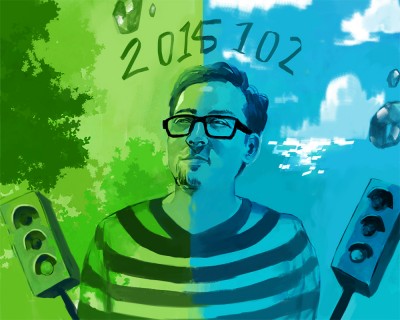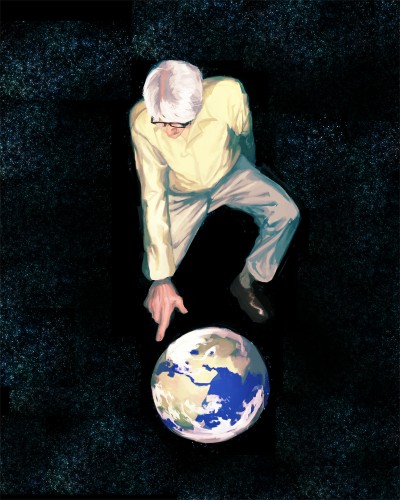Until Friday, May 15: Works by philosophy student Si-Won Song ’15; Free and open to all; 3rd Floor Atrium, Wyatt Hall
TACOMA, Wash. – Have you ever wondered if you would survive tele-transportation—where your body is broken down into particles and then reconstructed on another planet? Or if a person who knew all the laws of nature would be able to predict the future? Or what it would be like to plug into an “experience machine” that would allow you to experience everything you ever wanted?

These are some of the famous “thought experiments” that inspired the University of Puget Sound senior Si-Won Song ’15 to create a series of nine digital paintings, The Art of Thought Experiments, on view until Friday, May 15. The exhibit is in the third-floor atrium of Wyatt Hall, at Union Avenue and N. 13th Street. The hall is open to the public from 7 a.m. to 7 p.m.
“Thought experiments have a long history in philosophy, although they have also been used in mathematics and the sciences —such as Einstein’s imagining of someone chasing a beam of light,” said Ariela Tubert, associate professor and chair of the Department of Philosophy. “In thought experiments, the imagination is used to learn about the world and our own concepts and values.”
Artist Si-Won Song was born and raised in Seoul, South Korea, and moved to the United States while still in elementary school. He has lived in Tacoma ever since. He majored in painting and graphic design at Tacoma’s School of the Arts and is about to graduate from Puget Sound with a major in philosophy and minors in studio art and Japanese. He is concerned with social justice issues and works predominately with acrylics, charcoal, and digital painting.
“After taking the course Philosophy of Mind, with Professor Justin Tiehen, and reading Frank Jackson’s Mary’s Room thought experiment, I had a vivid mental image of the thought experiment and drew a small digital painting of it,” said Song. Mary’s Room asks us to imagine whether Mary—a neuroscientist who knows all the physical facts about color but has never seen color—would learn anything new upon seeing color for the first time.
Song continues, “The project started as a gift idea for all of my professors as a ‘thank you’ for putting up with me for the past four years. With the encouragement and support of my two advisors, it ended up becoming an independent study class. It grew into a larger project that involved the majority of the philosophy department, from faculty to students. This project is by a philosophy student, of people working in philosophy, and about philosophy.”

Elise Richman, associate professor of art and a faculty advisor for the project, commented, “There are historical sculptures and paintings, like The School of Athens depicting philosophers, and much contemporary art is conceptual—that is, it explores socially and politically pertinent ideas. But art that visually models philosophical ideas is unique.”
Each Song painting features Puget Sound philosophy students and/or professors—all of whom have considered the ideas incorporated in the paintings, Richman said. “The digital paintings are quite striking to behold; they draw the viewer in and encourage one to spend time looking and thinking about each image’s content. Si-Won makes philosophical ideas accessible and appealing.”
Among the paintings is one based on the famous Trolley Problem, created by philosopher Philippa Foot in 1967. We are asked to imagine five people strapped to a train track on one side and one person strapped to another track. You are in charge of the train set to go over the five people (and you have no time to unstrap them). Should you let the train go over the five or switch its course so that it goes on the other track and kills one person instead? Philosophers and psychologists use this imaginary scenario to consider our ethical concepts and judgments.
“While descriptions of thought experiments are often vivid and diagrams are sometimes provided, there are hardly any illustrations of them, ” said Tubert. “Si-Won’s art provides a captivating depiction of some of these most engaging philosophical arguments, and the Department of Philosophy is most enthusiastic and thankful for this work.”
For directions and a map of the University of Puget Sound campus: pugetsound.edu/directions
For accessibility information, please contact accessibility@pugetsound.edu or 253.879.3236, or visit pugetsound.edu/accessibility.
Press photos of the artworks are available upon request.
Photos on page: Top right: Mary's Room (with Brittney High '16) Above left: Grue (with Professor Justin Tiehen); Above right: LaPlace's Demon (with Professor Douglas Cannon)
